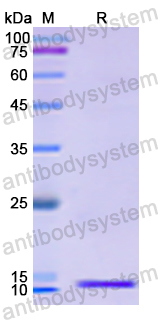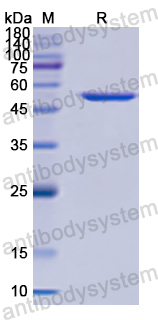Catalog No.
YHF67001
Expression system
E. coli
Species
Homo sapiens (Human)
Protein length
Asn416-Leu502
Predicted molecular weight
12.17 kDa
Nature
Recombinant
Endotoxin level
Please contact with the lab for this information.
Purity
>90% as determined by SDS-PAGE.
Accession
P78395
Applications
ELISA, Immunogen, SDS-PAGE, WB, Bioactivity testing in progress
Form
Lyophilized
Storage buffer
Lyophilized from a solution in PBS pH 7.4, 0.02% NLS, 1mM EDTA, 4% Trehalose, 1% Mannitol.
Reconstitution
Reconstitute in sterile water for a stock solution. A copy of datasheet will be provided with the products, please refer to it for details.
Shipping
In general, proteins are provided as lyophilized powder/frozen liquid. They are shipped out with dry ice/blue ice unless customers require otherwise.
Stability and Storage
Use a manual defrost freezer and avoid repeated freeze thaw cycles. Store at 2 to 8°C for frequent use. Store at -20 to -80°C for twelve months from the date of receipt.
Alternative Names
Opa-interacting protein 4, Preferentially expressed antigen of melanoma, MAPE, OIP-4, Melanoma antigen preferentially expressed in tumors, PRAME, OIP4
Focal High-Grade Areas with a Tumor-in-Tumor Pattern: Another Feature of Pediatric DICER1-Associated Thyroid Carcinoma?, PMID:40448797
Cancer-testis antigen expression in canine melanoma and healthy tissues., PMID:40359694
Development of a nano-vaccine for high-grade serous ovarian cancer., PMID:40338561
The combined diagnostic value of 5-hmC and PRAME immunohistochemistry in melanocytic neoplasms., PMID:40328178
Diagnostic Utility of Preferentially Expressed Antigen in Melanoma (PRAME) and p16 Immunohistochemistry in Distinguishing Genital Melanomas From Benign Melanocytic Proliferations., PMID:40314660
The University of Florida Dermatopathology Experience With the Pigmented Lesion Assay., PMID:40314644
Co-occurrence of EIF1AX, SF3B1, or BAP1 variants in uveal melanomas: A case series and review., PMID:40271082
Beyond Checkpoint Inhibition: Keeping Therapeutic Options Open., PMID:40233298
Digital quantification of Ki67 and PRAME in challenging melanocytic lesions - A novel diagnostic tool., PMID:40209567
Expression of Cancer-Testis Antigens MAGE-A1, MAGE-A4, NY-ESO-1 and PRAME in Bone and Soft Tissue Sarcomas: The Experience From a Single Center in China., PMID:40152485
Targeting PRAME directly or via EZH2 inhibition overcomes retinoid resistance and represents a novel therapy for keratinocyte carcinoma., PMID:40101298
Absence of pre-transplant T cell response against LAA is associated with Flt3-ITD mutation and increased relapse-risk in AML patients with HSCT., PMID:40099461
Molecular genomic insights into melanoma associated proteins PRAME and BAP1., PMID:40084617
Prognostic Biomarkers in Breast Cancer via Multi-Omics Clustering Analysis., PMID:40076569
PRAME Expression in Melanoma is Negatively Regulated by TET2-Mediated DNA Hydroxymethylation., PMID:40024557
What is the predominant etiological factor for Merkel cell carcinoma in Turkey: viral infection or sun exposure?, PMID:40001006
Spitz Spindle Cell/Reed Nevus With SQSTM1 :: NTRK2 Fusion and Atypical Features in an Older Male Patient: A Case Report and Review of Literature., PMID:39980385
Clinicopathologic and genomic analyses of SMARCA4-mutated non-small cell lung carcinoma implicate the needs for tailored treatment strategies., PMID:39954349
[Inflammatory juvenile conjunctival nevus: a clinicopathological analysis of 19 cases]., PMID:39939005
Multi-omics analyses reveal biological and clinical insights in recurrent stage I non-small cell lung cancer., PMID:39929832
Characterization of the genomic landscape of canine diffuse large B-cell lymphoma reveals recurrent H3K27M mutations linked to progression-free survival., PMID:39922874
Clinicopathologic Features of PRAME-Positive Common Melanocytic Nevi: A Case-Control Study., PMID:39912627
A panel of cancer testis antigens in squamous cell carcinoma of the lung, head and neck, and esophagus: implication for biomarkers and therapeutic targets., PMID:39864021
Expression evaluated by digital image analysis techniques of PRAME more than MCM6 is associated with poor prognosis in neuroblastoma: A pilot study with 84 cases., PMID:39842731
An immunohistochemical and molecular genetic study of 60 colorectal carcinoma brain metastases in pursuit of predictive biomarkers for cancer therapy., PMID:39824298
The Relationship of PRAME Expression with Clinicopathologic Parameters and Immunologic Markers in Melanomas: In Silico Analysis., PMID:39774089
PRAME Immunostaining in BAP-1-Inactivated Melanocytic Tumors: Unraveling Diagnostic Complexity and Exploring Germline Mutation Associations., PMID:39761650
The Diagnostic Utility of PRAME in Primary Cutaneous Dedifferentiated and Transdifferentiated Melanomas., PMID:39748565
Combined immunohistochemistry of PRAME and p16 in the differentiation of melanocytic neoplasms, with a detailed focus on acral lesions., PMID:39731107
Fatal Spitz Melanoma With MAD1L1::BRAF Fusion: A Case Report and Literature Review., PMID:39723589
Expression of PRAME in high-grade serous carcinoma is associated with higher residual disease volume and Occludin expression., PMID:39709875
ERBB2/ERBB3-mutated S100/SOX10-positive uterine sarcoma: something new., PMID:39666109
High-affinity T cell receptor ImmTAC® bispecific efficiently redirects T cells to kill tumor cells expressing the cancer-testis antigen PRAME., PMID:39659431
Immunohistochemical Expression and Significance of Preferentially Expressed Antigen in Melanoma (PRAME) in Gynecological Tumors: A Single-institution Retrospective Analysis., PMID:39626912
The Influence of Melanoma Extracellular Vesicles on Benign Melanocytes: A Role for PRAME in Modulation of the Tumor Microenvironment., PMID:39608669
EZH2 inhibition sensitizes retinoic acid-driven senescence in synovial sarcoma., PMID:39550391
[Significance of the preferentially expressed antigen in melanoma in discriminating the conjunctival malignant melanoma and pigmented nevus]., PMID:39505373
Broadening alloselectivity of T cell receptors by structure guided engineering., PMID:39500929
The Utilization of PRAME in the Diagnosis, Prognosis, and Treatment of Melanoma., PMID:39451258
Role of Immunohistochemistry in the Diagnosis of Pilomatrical Tumors., PMID:39450990
Utilizing PRAME Expression and a Meta-Analytic Framework for iSALT to Explore Atypical Late-Onset Nevi of the Elderly and Their Relationship With Lentiginous and Nested Nevoid Melanomas., PMID:39412342
The Utility of PRAME and Ki-67 as Prognostic Markers for Cutaneous Melanoma., PMID:39412340
Follicular dendritic cell sarcoma involving the parotid gland with expression of the melanocytic marker PRAME., PMID:39379758
Spitz melanoma with MAP3K8::ABLIM1 rearrangement: a case report with review of the literature., PMID:39363234
PRAME expression in fibrosarcomatous dermatofibrosarcoma protuberans., PMID:39362949
A comprehensive review of PRAME and BAP1 in melanoma: Genomic instability and immunotherapy targets., PMID:39326690
BRCA1-associated-protein-1 inactivated melanocytic tumours: characterisation of the clinicopathological spectrum and immunohistochemical expression pattern of preferentially expressed antigen in melanoma., PMID:39268598
Brief Communication on MAGE-A4 and Coexpression of Cancer Testis Antigens in Metastatic Synovial Sarcomas: Considerations for Development of Immunotherapeutics., PMID:39224047
T Cell-Engaging Bispecific Antibodies Targeting gp100 and PRAME: Expanding Application from Uveal Melanoma to Cutaneous Melanoma., PMID:39204391
NRASQ61R-driven atypical melanocytic tumor with blue nevus-like morphology: A case report., PMID:39177027


